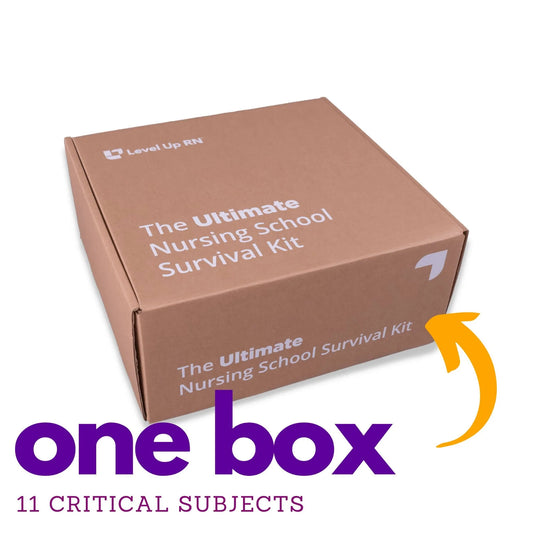Nursing Tips
Nervous (42)
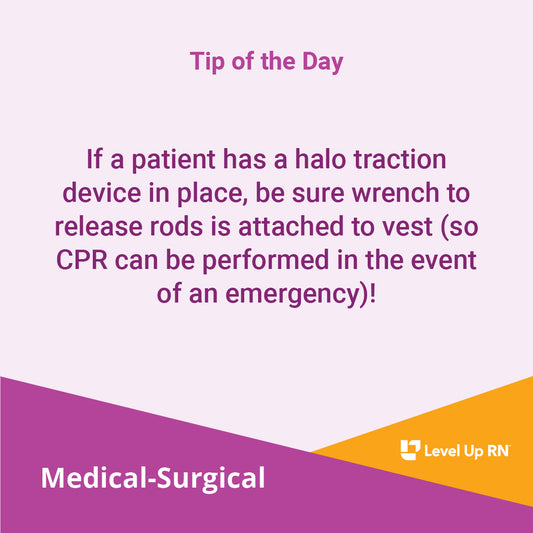
Halo Traction Devices
If a patient has a halo traction device in place, be sure wrench to release rods is attached to vest (so CPR can be performed in the event of an...
Halo Traction Devices
If a patient has a halo traction device in place, be sure wrench to release rods is attached to vest (so CPR can be performed in the event of an...
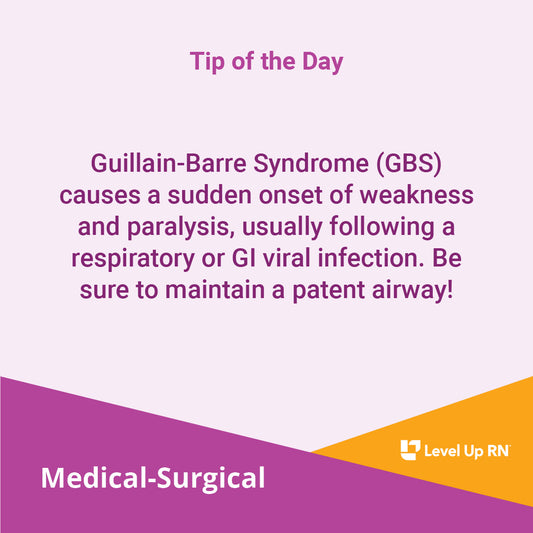
Guillain-Barre Syndrome (GBS)
Guillain-Barre Syndrome (GBS) causes a sudden onset of weakness and paralysis, usually following a respiratory or GI viral infection. Be sure to maintain a patent airway!
Guillain-Barre Syndrome (GBS)
Guillain-Barre Syndrome (GBS) causes a sudden onset of weakness and paralysis, usually following a respiratory or GI viral infection. Be sure to maintain a patent airway!

Applying Topical Lidocaine Cream
For topical lidocaine cream (e.g., EMLA cream) to numb an area, be sure to apply it 1 hour before the procedure and cover it with an occlusive dressing.
Applying Topical Lidocaine Cream
For topical lidocaine cream (e.g., EMLA cream) to numb an area, be sure to apply it 1 hour before the procedure and cover it with an occlusive dressing.
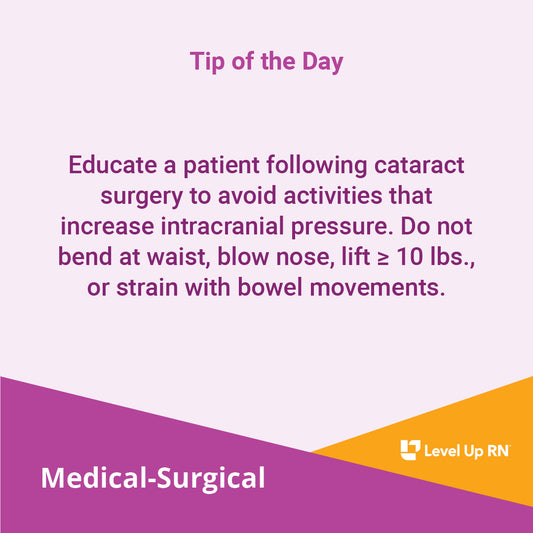
Cataract Surgery: Patient Teaching
Educate a patient following cataract surgery to avoid activities that increase intracranial pressure. Do not bend at waist, blow nose, lift ≥ 10 lbs., or strain with bowel movements.
Cataract Surgery: Patient Teaching
Educate a patient following cataract surgery to avoid activities that increase intracranial pressure. Do not bend at waist, blow nose, lift ≥ 10 lbs., or strain with bowel movements.
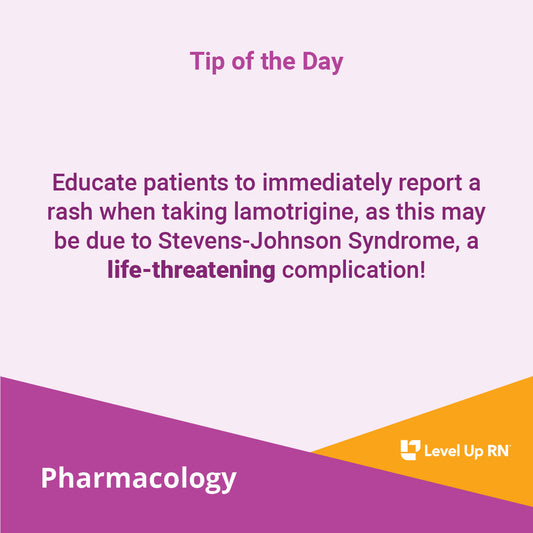
Lamotrigine: Patient Teaching
Educate patients to immediately report a rash when taking lamotrigine, as this may be due to Stevens-Johnson Syndrome, a life-threatening complication!
Lamotrigine: Patient Teaching
Educate patients to immediately report a rash when taking lamotrigine, as this may be due to Stevens-Johnson Syndrome, a life-threatening complication!
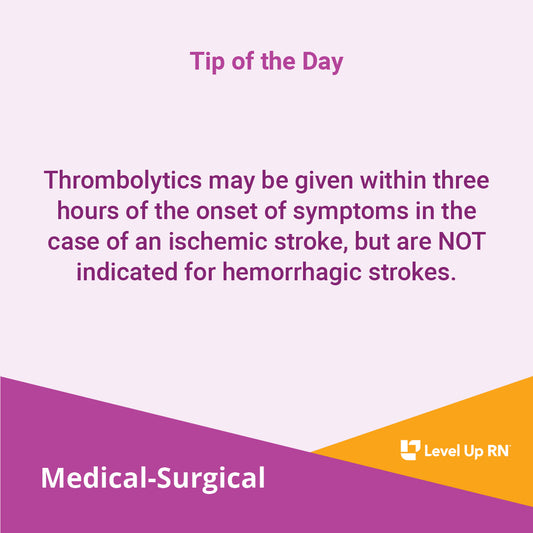
Thrombolytics
Thrombolytics may be given within three hours of the onset of symptoms in the case of an ischemic stroke, but are NOT indicated for hemorrhagic strokes.
Thrombolytics
Thrombolytics may be given within three hours of the onset of symptoms in the case of an ischemic stroke, but are NOT indicated for hemorrhagic strokes.
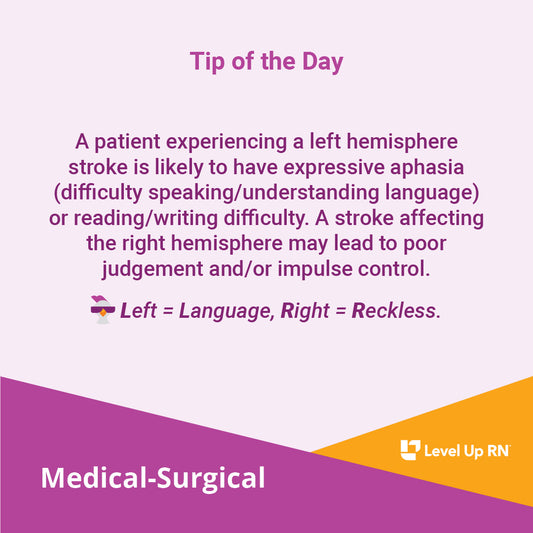
Stroke: Right versus Left Hemisphere
A patient experiencing a left hemisphere stroke is likely to have expressive aphasia (difficulty speaking/understanding language) or reading/writing difficulty. A stroke affecting the right hemisphere may lead to poor judgement...
Stroke: Right versus Left Hemisphere
A patient experiencing a left hemisphere stroke is likely to have expressive aphasia (difficulty speaking/understanding language) or reading/writing difficulty. A stroke affecting the right hemisphere may lead to poor judgement...

Autonomic Nervous System
The autonomic nervous system is comprised of two parts: the sympathetic nervous system ("fight or flight" responses) and the parasympathetic nervous system ("rest and digest" functions).
Autonomic Nervous System
The autonomic nervous system is comprised of two parts: the sympathetic nervous system ("fight or flight" responses) and the parasympathetic nervous system ("rest and digest" functions).
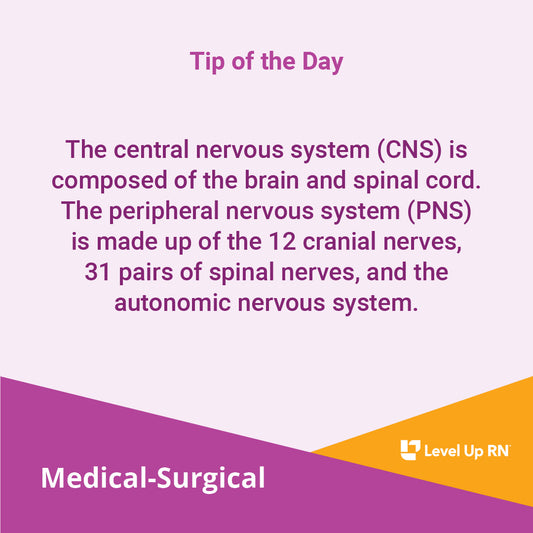
Central Nervous System (CNS)
The central nervous system (CNS) is composed of the brain and spinal cord.
Central Nervous System (CNS)
The central nervous system (CNS) is composed of the brain and spinal cord.

Autonomic Dysreflexia
A patient with a spinal cord injury is at risk for experiencing life-threatening hypertension known as autonomic dysreflexia.
Autonomic Dysreflexia
A patient with a spinal cord injury is at risk for experiencing life-threatening hypertension known as autonomic dysreflexia.

Tonic-clonic Seizure
After a tonic-clonic seizure, a patient enters the "postictal phase," and may exhibit confusion, sleepiness, or agitation.
Tonic-clonic Seizure
After a tonic-clonic seizure, a patient enters the "postictal phase," and may exhibit confusion, sleepiness, or agitation.
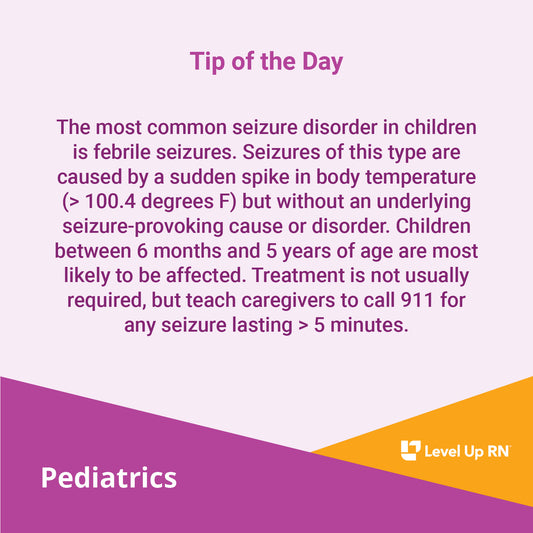
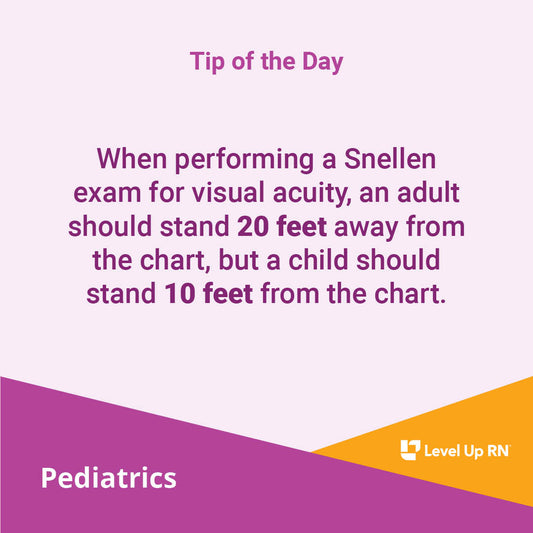
Performing a Snellen Exam
When performing a Snellen exam for visual acuity, an adult should stand 20 feet away from the chart, but a child should stand 10 feet from the chart.
Performing a Snellen Exam
When performing a Snellen exam for visual acuity, an adult should stand 20 feet away from the chart, but a child should stand 10 feet from the chart.
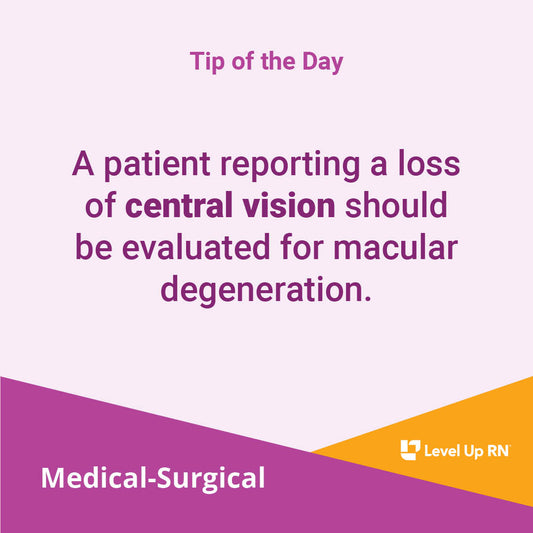
Loss of Central Vision
A patient reporting a loss of central vision should be evaluated for macular degeneration.
Loss of Central Vision
A patient reporting a loss of central vision should be evaluated for macular degeneration.
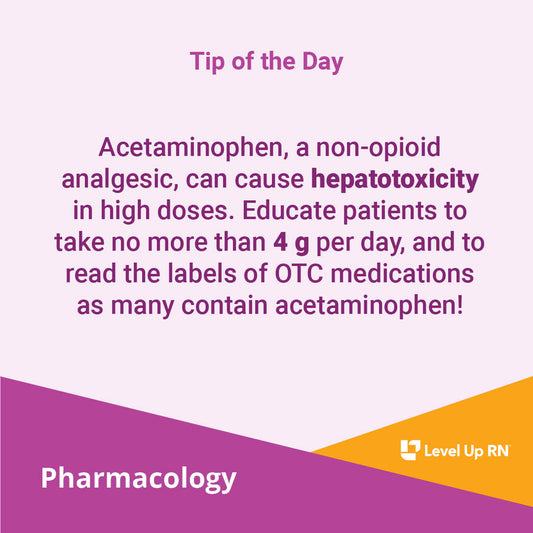
Acetaminophen: Patient Teaching
Acetaminophen, a non-opioid analgesic, can cause hepatotoxicity in high doses.
Acetaminophen: Patient Teaching
Acetaminophen, a non-opioid analgesic, can cause hepatotoxicity in high doses.
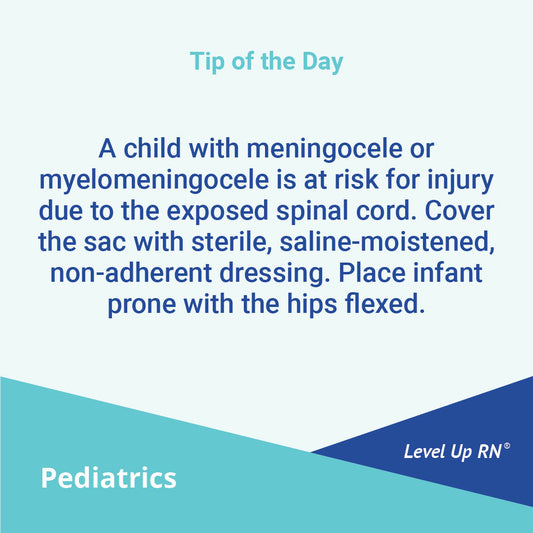
Meningocele and Myelomeningocele in Children
A child with meningocele or myelomeningocele is at risk for injury due to the exposed spinal cord. Cover the sac with sterile, saline-moistened, non-adherent dressing. Place infant prone with the...
Meningocele and Myelomeningocele in Children
A child with meningocele or myelomeningocele is at risk for injury due to the exposed spinal cord. Cover the sac with sterile, saline-moistened, non-adherent dressing. Place infant prone with the...

Meningitis in Children
A child with meningitis is likely to have a fever, headache, nausea, vomiting, irritability, nuchal (neck) rigidity, photophobia, and + Kernig's and Brudzinski's signs.
Meningitis in Children
A child with meningitis is likely to have a fever, headache, nausea, vomiting, irritability, nuchal (neck) rigidity, photophobia, and + Kernig's and Brudzinski's signs.
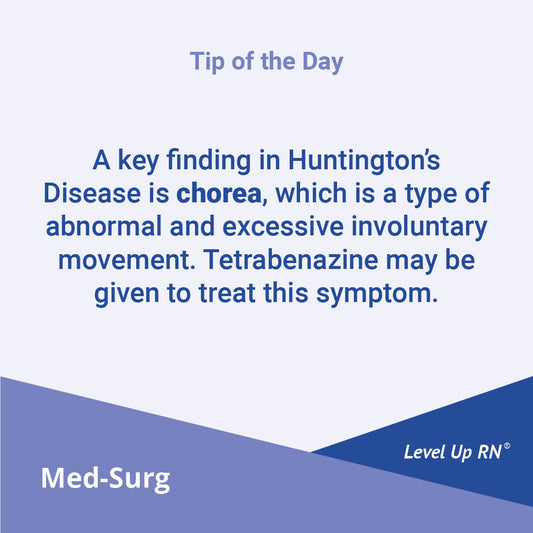
Chorea and Huntington's Disease
A key finding in Huntington's Disease is chorea, which is a type of abnormal and excessive involuntary movement. Tetrabenazine may be given to treat this symptom.
Chorea and Huntington's Disease
A key finding in Huntington's Disease is chorea, which is a type of abnormal and excessive involuntary movement. Tetrabenazine may be given to treat this symptom.

Phenytoin and Gingival Hyperplasia
A key side effect of phenytoin (an anti-seizure medication) is gingival hyperplasia. Educate patients to maintain regular dental checkups.
Phenytoin and Gingival Hyperplasia
A key side effect of phenytoin (an anti-seizure medication) is gingival hyperplasia. Educate patients to maintain regular dental checkups.
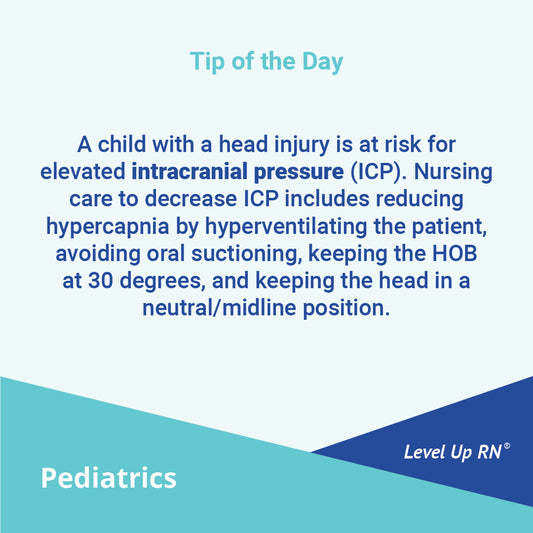
Intracranial Pressure (ICP); Nursing Care
A child with a head injury is at risk for elevated intracranial pressure (ICP). Nursing care to decrease ICP includes reducing hypercapnia by hyperventilating the patient, avoiding oral suctioning, keeping...
Intracranial Pressure (ICP); Nursing Care
A child with a head injury is at risk for elevated intracranial pressure (ICP). Nursing care to decrease ICP includes reducing hypercapnia by hyperventilating the patient, avoiding oral suctioning, keeping...
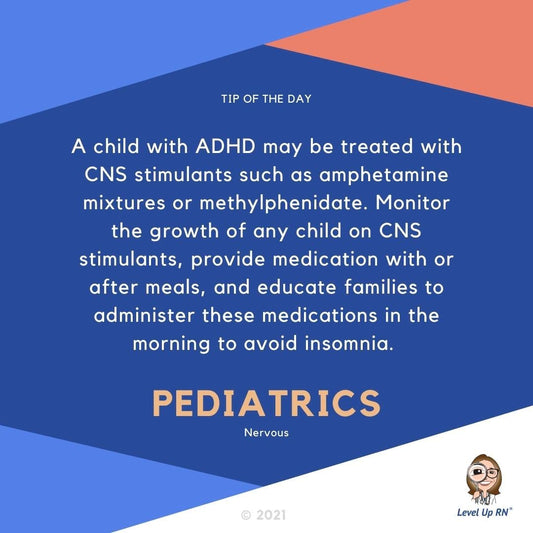
ADHD in Children: Treatment and Nursing Care
A child with ADHD may be treated with CNS stimulants such as amphetamine mixtures or methylphenidate.
ADHD in Children: Treatment and Nursing Care
A child with ADHD may be treated with CNS stimulants such as amphetamine mixtures or methylphenidate.

Spina Bifida Occulta
A child who presents with an abnormal tuft of hair, a dimple, or a birthmark on the spine should be evaluated for spina bifida occulta, a form of spina bifida....
Spina Bifida Occulta
A child who presents with an abnormal tuft of hair, a dimple, or a birthmark on the spine should be evaluated for spina bifida occulta, a form of spina bifida....

Absence Seizures: Signs and Symptoms
A child who appears to be frequently "day dreaming" or often exhibits blank staring, eye fluttering, lip smacking, or picking at clothes should be evaluated for absence seizures.
Absence Seizures: Signs and Symptoms
A child who appears to be frequently "day dreaming" or often exhibits blank staring, eye fluttering, lip smacking, or picking at clothes should be evaluated for absence seizures.

Signs and Symptoms of Autism
Key signs/symptoms of Autism: Lack of eye contact Repetitive motions/actions Delayed speech and language skills Strict adherence to routines Unusual eating or sleeping habits Digestive problems.
Signs and Symptoms of Autism
Key signs/symptoms of Autism: Lack of eye contact Repetitive motions/actions Delayed speech and language skills Strict adherence to routines Unusual eating or sleeping habits Digestive problems.

Extrapyramidal Side Effects
Extrapyramidal side effects (EPS) are common with Conventional Antipsychotics. Symptoms of EPS include: Dystonia, Parkinson's symptoms, Tardive dyskinesia, Akathisia.
Extrapyramidal Side Effects
Extrapyramidal side effects (EPS) are common with Conventional Antipsychotics. Symptoms of EPS include: Dystonia, Parkinson's symptoms, Tardive dyskinesia, Akathisia.

Early Signs of Increased ICP in Infants
Early signs of increased ICP in infants: irritability, high-pitched cry, poor feeding, “setting-sun” phenomenon, bulging fontanels, separation of cranial sutures.
Early Signs of Increased ICP in Infants
Early signs of increased ICP in infants: irritability, high-pitched cry, poor feeding, “setting-sun” phenomenon, bulging fontanels, separation of cranial sutures.

Clozapine vs. Clonidine
Don't confuse clozapine with clonidine! Clonidine is an antihypertensive. Clozapine is an antipsychotic.
Clozapine vs. Clonidine
Don't confuse clozapine with clonidine! Clonidine is an antihypertensive. Clozapine is an antipsychotic.

Dementia vs. delirium
Dementia vs delirium: Dementia has slow onset, does NOT alter vital signs, and is irreversible. Delirium has rapid onset, can alter vital signs and level of consciousness, and is reversible.
Dementia vs. delirium
Dementia vs delirium: Dementia has slow onset, does NOT alter vital signs, and is irreversible. Delirium has rapid onset, can alter vital signs and level of consciousness, and is reversible.

Donepezil & Alzheimer's
Donepezil is a KEY medication used for Alzheimer's disease. It does NOT cure the disease, but it may improve memory, cognition, and an individual’s ability to perform ADLs.
Donepezil & Alzheimer's
Donepezil is a KEY medication used for Alzheimer's disease. It does NOT cure the disease, but it may improve memory, cognition, and an individual’s ability to perform ADLs.

Amitriptyline
Amitriptyline is a Tricyclic Antidepressant. "Amy tripped over a tricycle in the desert". Desert helps you remember anticholinergic side effects (urinary retention, constipation, dry mouth, blurry vision, photophobia, tachycardia)
Amitriptyline
Amitriptyline is a Tricyclic Antidepressant. "Amy tripped over a tricycle in the desert". Desert helps you remember anticholinergic side effects (urinary retention, constipation, dry mouth, blurry vision, photophobia, tachycardia)
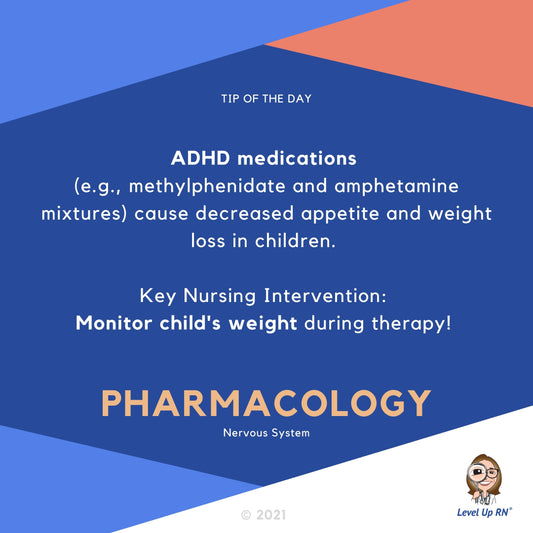
ADHD Medication and Children's Weight
ADHD medications cause decreased appetite and weight loss in children.
ADHD Medication and Children's Weight
ADHD medications cause decreased appetite and weight loss in children.
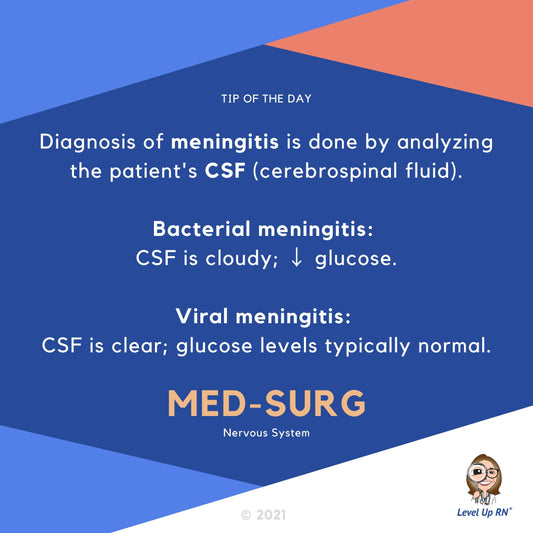
Meningitis diagnosis
Diagnosis of meningitis is done by analyzing the patient's CSF (cerebrospinal fluid).
Meningitis diagnosis
Diagnosis of meningitis is done by analyzing the patient's CSF (cerebrospinal fluid).

Lithium
Lithium is a mood stabilizer, used for Bipolar Disorder. Patients on lithium need adequate fluid and sodium intake! Diuretics, anticholinergics, NSAIDs are not recommended.
Lithium
Lithium is a mood stabilizer, used for Bipolar Disorder. Patients on lithium need adequate fluid and sodium intake! Diuretics, anticholinergics, NSAIDs are not recommended.

MAOIS for Depression
MAOIs are used to treat depression. Important points about MAOIs: They interact with MANY other medications. Eating foods rich in tyramine can cause a hypertensive crisis. Foods rich in tyramine include...
MAOIS for Depression
MAOIs are used to treat depression. Important points about MAOIs: They interact with MANY other medications. Eating foods rich in tyramine can cause a hypertensive crisis. Foods rich in tyramine include...

Valproic Acid
Valproic acid is an antiepileptic drug. Key side effect is hepatotoxicity! Carefully monitor liver lab values (ex: AST, ALT).
Valproic Acid
Valproic acid is an antiepileptic drug. Key side effect is hepatotoxicity! Carefully monitor liver lab values (ex: AST, ALT).
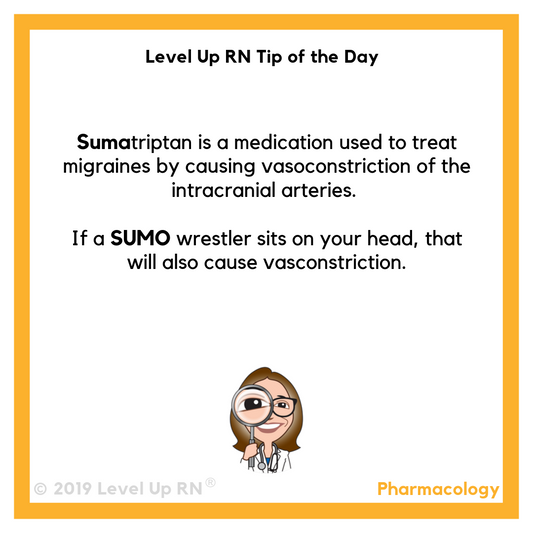
Sumatriptan
Sumatriptan is a medication used to treat migraines by causing vasoconstriction of the intracranial arteries. If a SUMO wrestler sits on your head, that will also cause vasoconstriction.
Sumatriptan
Sumatriptan is a medication used to treat migraines by causing vasoconstriction of the intracranial arteries. If a SUMO wrestler sits on your head, that will also cause vasoconstriction.

Zolpidem (Ambien) Uses
Zolpidem (Ambien) is used for insomnia. Zolpidem will help you catch some ZZZs...
Zolpidem (Ambien) Uses
Zolpidem (Ambien) is used for insomnia. Zolpidem will help you catch some ZZZs...

Major Risk Factor for Reye's Syndrome
Major risk factor for Reye's syndrome: Use of aspirin to treat fever associated with a viral infection.
Major Risk Factor for Reye's Syndrome
Major risk factor for Reye's syndrome: Use of aspirin to treat fever associated with a viral infection.
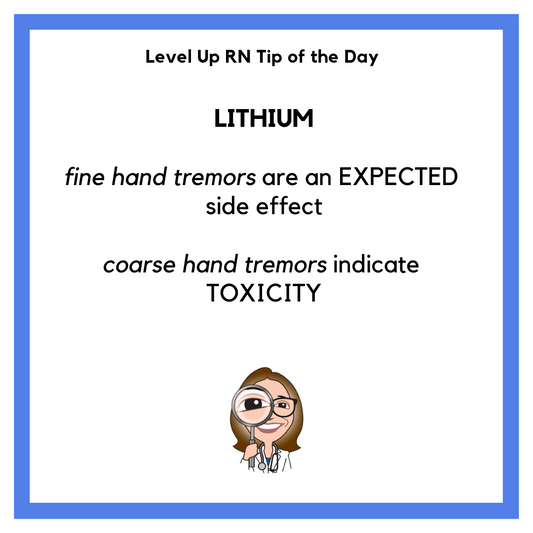
Lithium Side Effects vs. Toxicity
Lithium: fine hand tremors are an EXPECTED side effect, coarse hand tremors indicate TOXICITY.
Lithium Side Effects vs. Toxicity
Lithium: fine hand tremors are an EXPECTED side effect, coarse hand tremors indicate TOXICITY.

SSRIs and Serotonin Syndrome
For patients taking SSRIs, watch for serotonin syndrome! Symptoms: agitation, hallucinations, fever, diaphoresis, tremors.
SSRIs and Serotonin Syndrome
For patients taking SSRIs, watch for serotonin syndrome! Symptoms: agitation, hallucinations, fever, diaphoresis, tremors.

How to treat a seizure
During a seizure, turn the patient to his/her side, loosen restrictive clothing, and DO NOT insert airway or restrain patient.
How to treat a seizure
During a seizure, turn the patient to his/her side, loosen restrictive clothing, and DO NOT insert airway or restrain patient.
Filter Articles
Shop
The Ultimate Nursing School Survival Kit - Flashcards
4.872881355 / 5.0
(236) 236 total reviews
Regular price $349.95Regular priceUnit price / per$469.95Sale price $349.95SaleVideos by Subject
Tips & More
Exam Information
Subscribe



